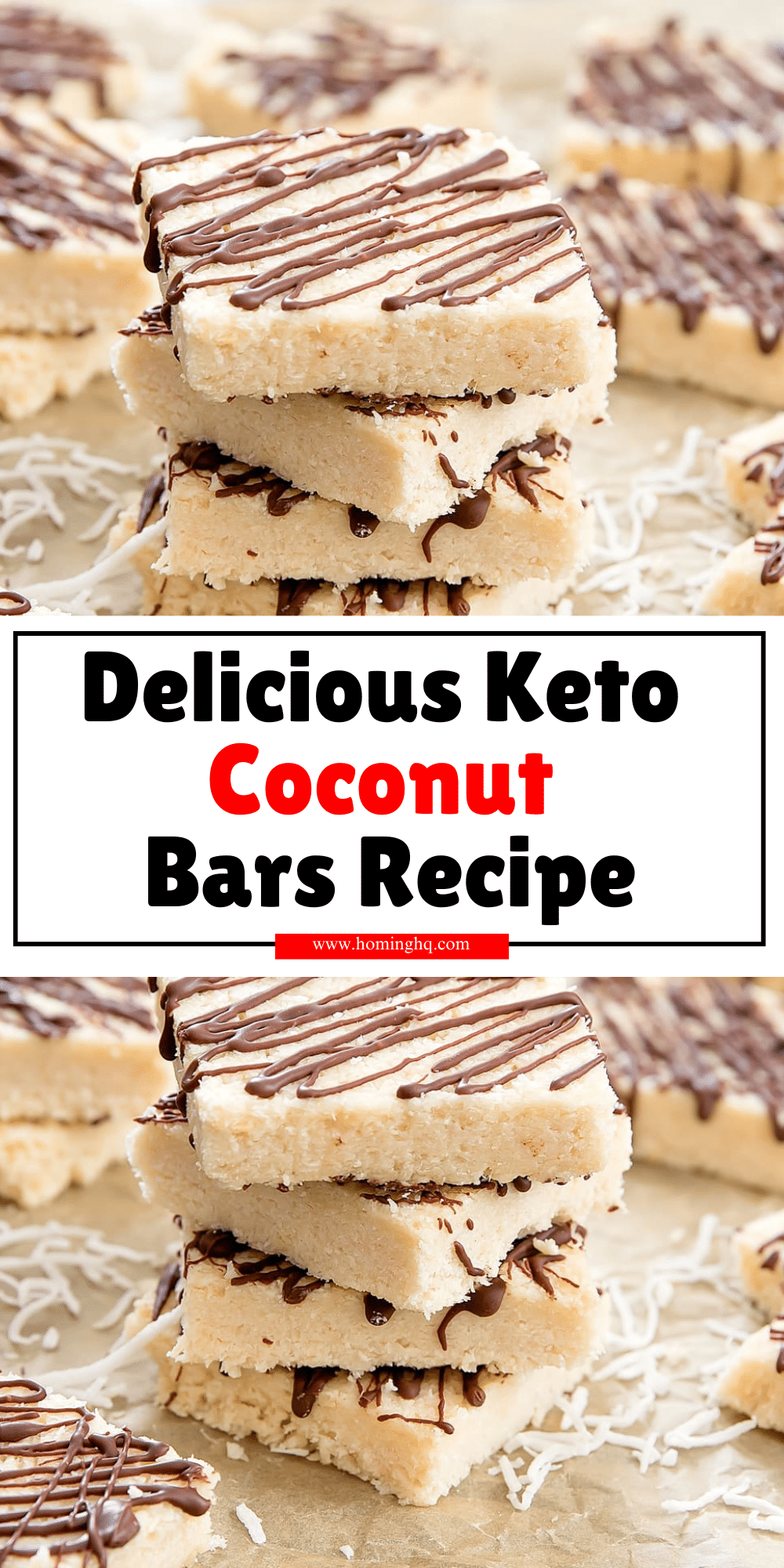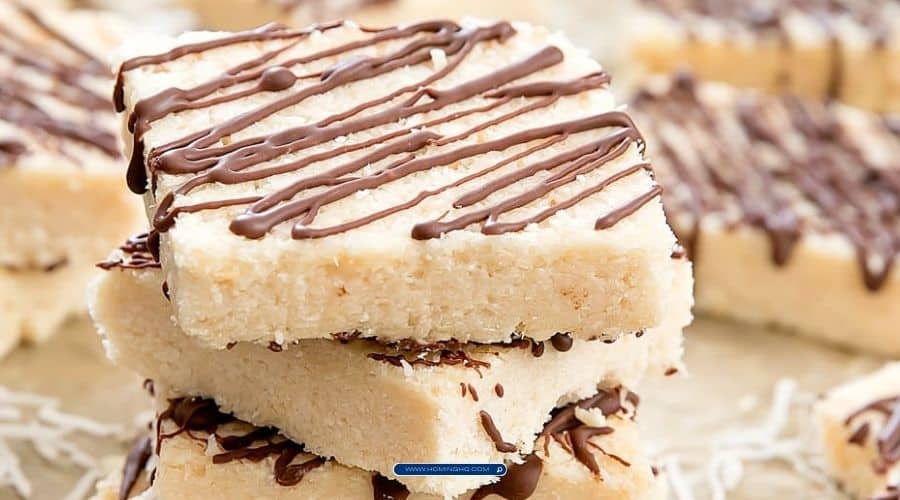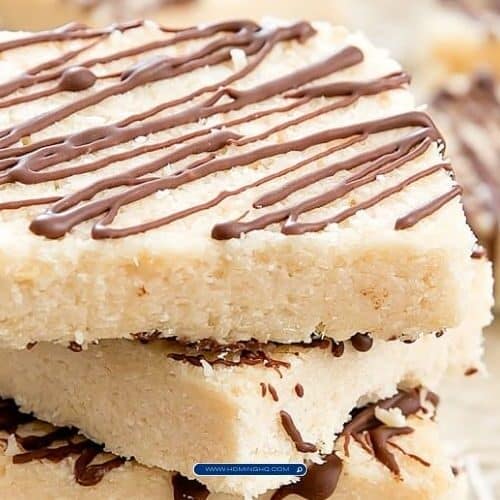If you’re following a ketogenic diet and craving a delicious treat that satisfies your sweet tooth without compromising your macros, then look no further! Keto Coconut Bars are the perfect solution.
These bars are low in carbs, packed with healthy fats, and rich in coconut flavor, making them an ideal snack for anyone on a low-carb or keto lifestyle.
Whether you’re in need of a quick energy boost or looking for a simple dessert to enjoy after a meal, these coconut bars check all the boxes. Easy to make and full of flavor, they will quickly become a favorite in your keto recipe collection.

What Are Keto Coconut Bars?
Keto Coconut Bars are a sweet, chewy, and crunchy dessert designed specifically for people following a ketogenic diet.
Unlike traditional coconut bars, which are often packed with sugar and carbs, these bars are made with keto-friendly ingredients like unsweetened shredded coconut, almond flour, and natural sweeteners such as erythritol or stevia.
The result is a treat that is low in carbs but high in healthy fats, making it perfect for maintaining ketosis, the metabolic state that burns fat for energy.
The beauty of keto coconut bars lies in their simplicity.
With a few pantry staples, you can create a satisfying snack or dessert that won’t spike your blood sugar or kick you out of ketosis. They are a great alternative to traditional sugary snacks and can be customized with optional toppings like dark chocolate or nuts for added flavor and texture.
Ingredients for Keto Coconut Bars
To make these delicious Keto Coconut Bars, you’ll need a few simple ingredients that pack in flavor without any of the excess carbs. Here’s a breakdown of what you’ll need:
Shredded Unsweetened Coconut
The main ingredient in these bars, shredded unsweetened coconut gives them a rich texture and a coconutty flavor. Make sure to choose unsweetened coconut to keep the carb count low and avoid any added sugars.
Almond Flour
Almond flour is a great low-carb alternative to traditional flour, providing structure to the bars while keeping them keto-friendly. It gives the bars a soft, slightly nutty flavor.
Coconut Oil or Butter
For binding the ingredients together and adding healthy fats, coconut oil or butter works wonderfully. It helps the bars hold together while contributing to their rich, smooth texture.
Sweetener (Erythritol or Stevia)
To sweeten the bars without adding sugar, use a keto-friendly sweetener like erythritol, stevia, or monk fruit. These sweeteners won’t raise your blood sugar levels, making them a perfect choice for a keto diet.
Eggs and Vanilla Extract
Eggs help bind the ingredients and give the bars their chewy texture. Vanilla extract adds a warm, fragrant flavor that enhances the overall taste of the coconut bars.
Optional: Dark Chocolate for Topping
For an extra indulgent touch, consider adding a layer of melted dark chocolate on top of the bars. Look for a variety that is at least 85% cocoa to keep the carb count low while enjoying a rich chocolate flavor.
Each ingredient has been carefully selected to ensure these bars remain keto-friendly, delicious, and satisfying. With these simple ingredients, you can create a snack that fits perfectly within your ketogenic lifestyle.
Step-by-Step Instructions

Making Keto Coconut Bars is simple and straightforward. Here’s how to create this delicious treat, step by step:
Step 1: Preparing the Base Mixture
Start by preheating your oven to 350°F (175°C) and lining a baking pan (around 8×8 inches) with parchment paper for easy removal later. This ensures the bars bake evenly and don’t stick to the pan.
In a large bowl, combine the dry ingredients: shredded unsweetened coconut and almond flour. Stir them together to distribute the ingredients evenly.
In a separate bowl, whisk together the eggs, melted coconut oil (or butter), and vanilla extract. Then, add your sweetener (erythritol or stevia) and stir until the mixture is smooth and well combined.
Once your wet and dry ingredients are ready, pour the wet mixture into the dry ingredients. Mix everything thoroughly until a dough-like consistency forms.
Step 2: Shaping the Bars
Transfer the mixture into your prepared baking pan. Use a spatula to spread it evenly and press it down firmly into the pan to ensure the bars bake uniformly. If you prefer thicker bars, feel free to adjust the amount of mixture you press into the pan, but keep in mind that thicker bars may need a little extra baking time.
Step 3: Baking the Bars
Place the baking pan in the preheated oven and bake for 15-18 minutes or until the edges of the bars are golden brown. You can also lightly press the center of the bars with your finger to check for firmness. If it’s soft or too sticky, give it a few extra minutes.
Once baked, remove the pan from the oven and allow the bars to cool in the pan for about 10 minutes. Afterward, transfer them to a wire rack to cool completely.
Step 4: Cooling and Optional Toppings
After the bars have cooled, you can either enjoy them as they are or add an extra layer of indulgence. Melt some dark chocolate (at least 85% cocoa) and pour it over the bars. Let the chocolate set for 30 minutes in the refrigerator before slicing.
For an additional flavor boost, you can sprinkle some shredded coconut or crushed nuts on top before the chocolate sets. This adds extra texture and makes the bars even more visually appealing.
Tips for Perfect Keto Coconut Bars
Making the perfect keto coconut bars is all about getting the right texture and flavor. Here are a few tips to ensure your bars turn out just right:
Tip 1: Use Fresh, High-Quality Coconut
To get the best flavor and texture, always use fresh shredded unsweetened coconut. Older coconut can sometimes be dry and less flavorful, which will impact the final taste of your bars. Fresh coconut adds a soft, chewy texture that makes these bars irresistible.
Tip 2: Don’t Skip the Sweetener
Even though the coconut naturally has some sweetness, the sweetener plays an essential role in achieving that classic coconut bar taste. Make sure to use a keto-friendly sweetener like erythritol or stevia to keep the carb count low while enhancing the overall flavor.
Tip 3: Customize the Texture
If you prefer a denser bar, use less almond flour or press the mixture more firmly into the pan. For a fluffier texture, add a bit more coconut oil or butter to create a lighter consistency. Both options are delicious, so choose the texture that you like best!
Tip 4: Let the Bars Cool Completely Before Cutting
It’s tempting to dive right in, but letting the bars cool completely before cutting them into squares ensures they hold their shape. Cooling also helps the bars firm up and makes them easier to handle.
Tip 5: Experiment with Toppings
While the bars are already delicious on their own, adding a chocolate topping or sprinkling some chopped nuts or extra coconut flakes can take them to the next level. A few creative additions will give your keto coconut bars a personalized touch.
Tip 6: Store for Freshness
These bars store well in an airtight container in the refrigerator for up to a week, making them perfect for meal prepping or having a keto-friendly snack on hand. For longer storage, you can freeze them for up to 3 months.
By following these tips, you can make sure your keto coconut bars are a satisfying and flavorful treat every time. Enjoy!
Variations of Keto Coconut Bars
While the basic recipe for Keto Coconut Bars is already fantastic, there are several ways you can customize and make them your own. Here are a few fun variations you can try:
Chocolate-Covered Keto Coconut Bars
If you’re a chocolate lover, you’ll appreciate this variation. Once your bars are baked and cooled, melt some keto-friendly dark chocolate (at least 85% cocoa) and spread it over the top of the bars. The richness of the chocolate pairs perfectly with the chewy coconut center, adding an extra layer of indulgence while keeping the bars keto-friendly. You can even sprinkle a little sea salt over the chocolate for a sweet-and-salty twist!
Keto Coconut Macaroons
If you prefer a chewier, fluffier texture, try shaping the mixture into small balls or mounds instead of pressing it into a baking pan. Bake them for 12-15 minutes at the same temperature, and you’ll have soft, chewy macaroons that are perfect for those who love a lighter coconut treat. For extra flavor, you can dip the macaroons halfway into melted dark chocolate and let them set before enjoying.
Adding Nuts or Seeds
For added crunch and flavor, try incorporating chopped nuts or seeds into your keto coconut bars. Walnuts, almonds, or even sunflower seeds can be mixed into the coconut mixture before baking. Not only do these additions bring a satisfying crunch, but they also boost the bars’ nutritional value, adding healthy fats and extra protein to keep you feeling fuller for longer.
Lemon Coconut Bars
For a fresh twist, add some lemon zest or a few tablespoons of lemon juice to the base mixture. This will infuse the bars with a refreshing citrus flavor that pairs beautifully with the coconut. The bright, tangy lemon makes for a refreshing contrast to the richness of the coconut, creating a perfect balance.
Pumpkin Spice Coconut Bars (Seasonal)
For a cozy fall treat, try adding pumpkin spice to the mixture, along with a couple of tablespoons of pure pumpkin puree. The spice and slight earthiness of the pumpkin complement the coconut and give the bars a seasonal twist that’s perfect for autumn.
Conclusion
Keto Coconut Bars are a simple, yet indulgent treat that will satisfy your sweet tooth while keeping you on track with your ketogenic lifestyle. Whether you enjoy them on their own or with added toppings, these bars are the perfect low-carb, high-fat snack to have on hand whenever the craving for something sweet strikes. With just a handful of simple ingredients, you can create a snack that is not only delicious but also fits perfectly into a keto diet.
Experiment with different variations to make these bars your own, and remember, the versatility of this recipe means you can enjoy them year-round. From the classic coconut flavor to chocolate-covered bars, you’ll never run out of ways to enjoy this easy and healthy keto dessert.
Frequently Asked Questions (FAQs)
- Can I use regular sugar instead of a keto-friendly sweetener?
- For a keto diet, it’s best to avoid regular sugar as it’s high in carbs. Instead, use sweeteners like erythritol, stevia, or monk fruit to keep the bars low-carb.
- Can I make these bars dairy-free?
- Yes, simply substitute coconut oil for butter, and you’ll have a fully dairy-free version of these coconut bars that still taste amazing.
- How long can I store Keto Coconut Bars?
- These bars will stay fresh in an airtight container in the refrigerator for up to one week. You can also freeze them for up to three months.
- Can I make Keto Coconut Bars without almond flour?
- Yes, you can substitute almond flour with coconut flour, but you’ll need to adjust the quantity. Generally, use 1/4 cup of coconut flour for every 1/2 cup of almond flour, as coconut flour absorbs more liquid.
- How do I make Keto Coconut Bars crispier?
- If you prefer a crispier texture, you can increase the baking time slightly or bake the bars at a lower temperature for longer. Just keep an eye on them to avoid burning.

Keto Coconut Bars
Equipment
- 8×8-inch baking pan (1)
- Parchment paper (for lining the pan) (1 sheet)
- Large mixing bowl (1)
- Whisk (1)
- Spatula (1)
- Cooling rack (1)
Ingredients
- 1 ½ cups shredded unsweetened coconut
- 1 cup almond flour
- ¼ cup coconut oil or butter, melted
- 2 large eggs
- 2 tsp vanilla extract
- ½ cup keto-friendly sweetener erythritol, stevia, or monk fruit
- Optional: ¼ cup dark chocolate 85% cocoa, melted, for topping
Instructions
- Preheat the Oven: Begin by preheating your oven to 350°F (175°C). Line an 8×8-inch baking pan with parchment paper for easy removal later.
- Prepare Dry Ingredients: In a large bowl, combine shredded unsweetened coconut and almond flour. Stir them together to ensure even distribution.
- Mix Wet Ingredients: In another bowl, whisk together the eggs, melted coconut oil (or butter), and vanilla extract. Stir in your choice of sweetener until fully incorporated.
- Combine Wet and Dry Ingredients: Pour the wet ingredients into the dry ingredients and mix until everything is well combined and a dough-like consistency forms.
- Shape and Press the Mixture: Transfer the mixture into the prepared baking pan. Press it down evenly using a spatula to ensure the bars are compact and uniform.
- Bake: Place the pan in the oven and bake for 15-18 minutes, or until the edges are golden brown and the bars are firm to the touch.
- Cool: Once baked, remove the pan from the oven and allow the bars to cool in the pan for 10 minutes. Then, transfer them to a cooling rack to cool completely.
- Optional Topping: For an extra indulgent touch, drizzle melted dark chocolate over the cooled bars and let it set in the refrigerator for 30 minutes before slicing.
- Serve and Enjoy: Once cooled and set, slice the bars into 12 even pieces and enjoy!
Notes
- Sweetener: You can adjust the amount of sweetener based on your personal taste. Start with ½ cup and add more if you prefer a sweeter bar.
- Storage: Store the bars in an airtight container in the refrigerator for up to 1 week or freeze for up to 3 months. To freeze, wrap each bar individually in plastic wrap before placing them in a freezer-safe bag.
- Texture Variations: For a denser bar, press the mixture down more firmly. For a fluffier texture, add a bit more coconut oil or butter.
- Alternative Flour: If you prefer a different flour, you can substitute almond flour with coconut flour (about ¼ cup for every ½ cup of almond flour) but keep in mind coconut flour absorbs more moisture.

